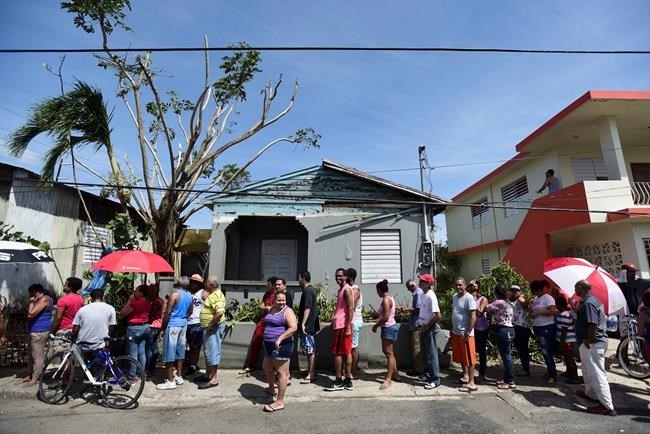
FILE - In this Sunday, Sept. 24, 2017 file photo, people affected by the passage of Hurricane Maria wait in line at Barrio Obrero to receive supplies from the National Guard, in San Juan, Puerto Rico. The bottlenecks appeared to be easing by the first weekend after the powerful storm, with thousands of Puerto Ricans finally getting water and food rations, even if help was yet to reach many on the island of 3.4 million people. (AP Photo/Carlos Giusti, File)
Republished October 01, 2017 - 9:46 AM
Original Publication Date September 30, 2017 - 9:11 PM
SAN JUAN, Puerto Rico - I was stunned as I walked through the darkened and humid arrivals terminal at San Juan's International Airport two days after Hurricane Maria blasted its way across Puerto Rico.
It was quiet. No military air traffic control units on the tarmac directing planeloads of aid supplies, no bustling command centre sending convoys of trucks to hard-hit areas. No mountains of relief goods stacked and ready to be deployed where needed.
There were a couple of airport employees mopping the still-damp floors of the terminal, the only sign of life in the vast space.
A Federal Emergency Management Agency guy stood at the curb smoking a cigarette as I came out looking for my ride, and we struck up a conversation. The man who gave his name as John said he and a crew from FEMA had been pre-positioned at the Intercontinental Hotel before the storm.
He told me they had spent the night moving from room to room as the ferocious winds tore chunks off the building. They ended up in the stairwell, which he said "was like a waterfall, the water gushing down the stairs like class 5 rapids."
"Where," I asked, "is the cavalry?" ''This is it," he replied, pointing to several dozen National Guard pilots and support people, along with several dozen local and federal officials milling around the Forward Operations Base near the civilian terminal of the airport.
I covered Hurricane Katrina in 2005 and the Haiti earthquake of 2010, among many natural disasters over the course of 30 years in journalism.
Disasters on the scale of Hurricane Maria are usually marked by the inspiring sight of thousands of military and federal emergency personnel flooding into the affected area.
Navy ships offshore, dozens of helicopters and cargo planes flying overhead, military convoys heading into affected areas with supplies and repair crews.
The only traffic on the still flooded highways that Friday consisted of civilians looking for gas, food, water or loved ones in the wake of the storm.
Twenty-thousand troops were sent into New Orleans after Hurricane Katrina flooded the city and surrounding areas. Thousands of foreign aid workers rushed into Haiti after the earthquake there levelled Port-Au-Prince, the capital. Within three days of that quake, the U.S. had dispatched some half-dozen ships and 5,500 soldiers and Marines.
In San Juan on Sept. 22, the only sign of relief efforts were beleaguered Puerto Rican government employees struggling to address the multitude of problems confronting the devastated island, while coping with their own losses from the storm.
In outlying areas, residents were left to fend for themselves, clearing roads, helping neighbours, sifting through the debris of their homes.
On a trip to the Guajataca Reservoir, about 60 miles (100 kilometres) west of San Juan, we came across a 25-year-old resident who refused to leave even though the Puerto Rico government declared an emergency evacuation, fearing the dam was about to burst and flood as many as 70,000 residents downstream.
She was pregnant and due to give birth in two days, but said she wasn't leaving because there "was nowhere to go." Her husband said they were better off in their damaged home, than relying on government help. "There is no government," he said, "here I have my family and neighbours to help me."
The bottlenecks appeared to be easing by this weekend, with thousands of Puerto Ricans finally getting water and food rations, even if help was yet to reach many on the island of 3.4 million people.
Military trucks carrying water bottles and other supplies began to reach even some remote parts of Puerto Rico and federal officials insisted more gains were coming soon.
The U.S. Navy hospital ship Comfort has been dispatched to the island and the Trump administration has named a three-star Army general to oversee military relief efforts.
Gov. Ricard Rossello blamed some of the problems on difficulties in getting aid shipments out of seaports and airports that were knocked out of commission in the storm, and then distributing the supplies on debris-strewn streets.
As I departed on Wednesday, lines of desperate people trying to leave the island clogged the sweltering airport terminal. But at least the long-awaited aid flights appeared to be landing, a sign of hope things might start getting a little better for those left behind.
___
This story has been corrected to reflect that the Guajataca Reservoir is west, not north, of San Juan.
News from © The Associated Press, 2017